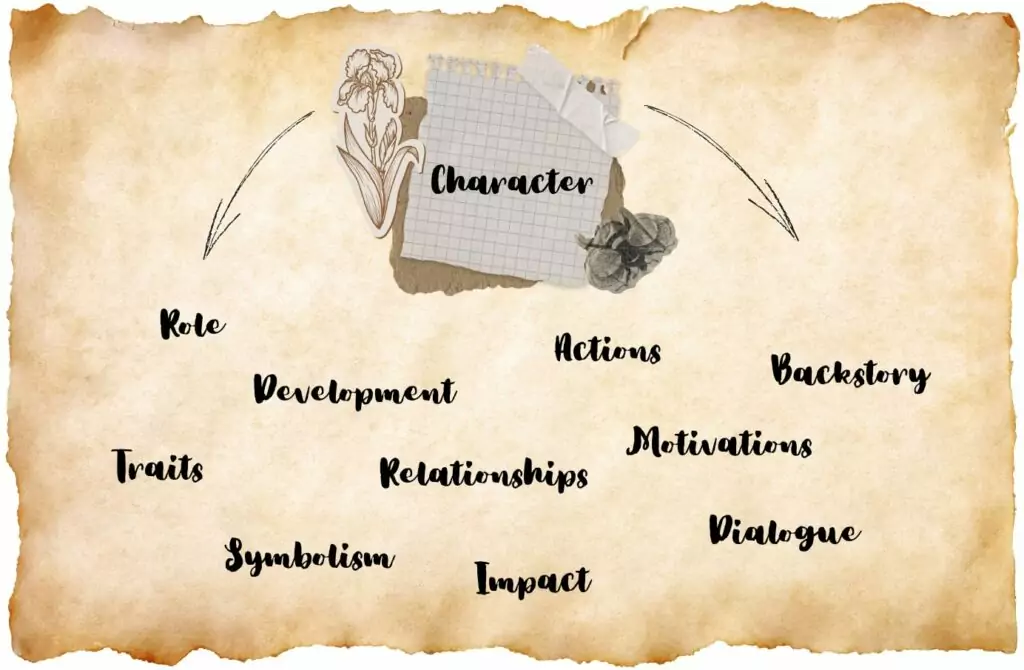How to Write a Character Analysis Essay

Writing a character analysis essay might sound like a fancy task, but it’s actually pretty straightforward once you get the hang of it. Imagine you’re getting to know a new friend—you’re curious about what makes them tick, why they act a certain way, and what their story is. That’s exactly what you’re doing with a character in a book, but on paper.
In this type of essay, you’re not just summarizing what the character does. You’re digging deeper, figuring out what drives them, how they change, and what they add to the story. Don’t worry if you’re feeling a bit lost. By the end of this guide, you’ll have a clear path to follow, making the whole process much easier than you might think. Ready to dive in? Let’s break it down together.
What Is a Character Analysis
Once again, a character analysis is like getting to know a new friend—except this friend lives in the pages of a book. When you do a character analysis, you’re trying to figure out who this character really is, beyond just the basic details. You’re asking questions like: What drives this character? How do they change over the course of the story? And why do they make the choices they do?
To get started, think about the character’s personality. Are they kind, brave, or maybe a little sneaky? You also want to look at their relationships with other characters—do they get along with others, or are they always causing trouble? Don’t forget to consider their background too. Where they come from can often explain why they act the way they do.
But there’s more to it than just describing the character. You need to connect the dots. How do their actions affect the plot? Do they grow or change as the story progresses? By answering these questions, you’re digging into the character’s role in the story, and that’s what makes a character analysis so interesting.
In the end, a good character analysis helps you see the character as a real person, with their own thoughts, feelings, and struggles. It’s not just about what they do in the story, but why they do it. Our Essay Writer can help you make sense of it.
Common Character Archetypes
When you’re reading a story, you might notice that certain types of characters keep popping up, even if the stories are totally different. These are called character archetypes, and they’re kind of like templates for building characters. Writers use them because they’re familiar and instantly recognizable, but each story puts its own spin on them. Understanding these archetypes can help you see patterns in stories and better understand the characters you read about.
Below, you’ll find a table with six common archetypes and a quick description of each. After that, we’ll dive into what makes each one unique.
| Archetype | Description |
| The Hero | A character who faces challenges and grows through them. |
| The Mentor | A guide or teacher who helps the hero on their journey. |
| The Everyman | An ordinary character who represents the average person. |
| The Villain | A character who opposes the hero, often embodying evil. |
| The Sidekick | A loyal companion who supports the hero. |
| The Trickster | A character who uses wit and mischief to achieve goals. |
The Hero
The Hero is probably the most well-known archetype. This character starts off as an ordinary person but is thrown into extraordinary circumstances. They’re often faced with challenges, dangers, or quests that push them to grow, learn, and ultimately triumph. Think of characters like Harry Potter or Katniss Everdeen. What sets the Hero apart is their journey—both physical and emotional. They evolve from someone unsure of their abilities into someone who can save the day. Heroes often have to make tough decisions and sacrifices, showing courage and resilience along the way.
The Mentor
The Mentor is the wise guide who helps the Hero along their journey. They’re usually older and have a lot of experience or knowledge that the Hero needs. Mentors can be strict, kind, or mysterious, but they all share one thing in common: they help the Hero grow. Think of Yoda from Star Wars or Dumbledore from Harry Potter. Mentors often give the Hero important tools or advice that they’ll need to succeed. However, they might also challenge the Hero, forcing them to think or act in new ways. What makes the Mentor special is their role as a teacher—someone who prepares the Hero for what’s ahead.
The Everyman
The Everyman is a character who feels like an average person, someone you might know in real life. They aren’t rich, famous, or powerful, but they’re relatable and down-to-earth. The Everyman often represents the common person, showing how ordinary individuals can play significant roles in a story. This archetype doesn’t seek out adventure or danger, but they might get caught up in it anyway. Characters like Bilbo Baggins from The Hobbit or Samwise Gamgee from The Lord of the Rings are good examples. The Everyman’s appeal lies in their normalcy; they show that you don’t have to be extraordinary to make a difference.
The Villain
The Villain is the character who stands in opposition to the Hero. They’re often portrayed as evil, but not always. Sometimes, Villains have understandable motives, but their actions put them at odds with the Hero. The Villain’s role is to create conflict, which drives the story forward. Classic Villains like Voldemort from Harry Potter or Darth Vader from Star Wars are easy to spot because of their malevolent intentions. However, a Villain can also be a more complex character, with layers that make them more than just the “bad guy.” What makes the Villain essential to a story is their ability to challenge the Hero, often bringing out the best (or worst) in them.
The Sidekick
The Sidekick is the Hero’s loyal companion, always ready to help out, even in the toughest situations. This archetype is usually supportive, offering encouragement, comic relief, or a helping hand when the Hero needs it most. Sidekicks like Ron Weasley from Harry Potter or Robin from Batman are there to back up the Hero, providing balance and sometimes even saving the day themselves. The Sidekick might not get the spotlight as much as the Hero, but their contribution is just as important. They’re often the unsung heroes, showing that teamwork and friendship are key to overcoming challenges.
The Trickster
The Trickster is a character who uses their wit, humor, and sometimes deception to achieve their goals. They’re clever, unpredictable, and often play by their own rules. Tricksters like Loki from Norse mythology or the Cheshire Cat from Alice in Wonderland keep the story interesting by adding an element of surprise. What sets the Trickster apart is their ability to shake things up. They might help the Hero, or they might create more problems, but they always keep you guessing. The Trickster’s role in a story is to challenge the status quo, often leading to unexpected twists and turns.
Each of these archetypes brings something unique to a story. By recognizing them, you can better understand how characters are built and how they drive the plot forward. So next time you’re reading a book or watching a movie, see if you can spot these archetypes in action.
How to Analyze a Character
Analyzing a character in a story is like putting together a puzzle. You’re looking at different pieces — like what they say, how they act, and how they interact with others — to understand who they really are. Whether you’re writing an essay or just trying to get more out of your reading, knowing how to analyze a character is a valuable skill. Let’s see how to write a character analysis, so you’ll know exactly what to look for.

1. Understand the Character’s Role in the Story
The first thing to consider is the character’s role. Are they the main character (protagonist), the one who opposes the main character (antagonist), or maybe a supporting character who helps move the story along? Understanding the role gives you a framework for your analysis.
For example, a protagonist usually faces challenges and changes over the course of the story. They’re often central to the plot, so analyzing them means looking at how they grow and what drives them. On the other hand, an antagonist creates conflict, so your analysis might focus on their motivations and how they impact the protagonist.
2. Examine the Character’s Traits
Next, dive into the character’s personality traits. Are they brave, selfish, kind, or maybe a bit sneaky? Look for adjectives that describe them and think about how these traits influence their actions and decisions. You can often find clues in how they talk, what they think, and how they respond to different situations.
For instance, a character who is cautious might hesitate before making decisions, while a reckless character might jump into action without thinking. These traits help define who the character is and make them feel real to the reader.
3. Analyze the Character’s Development
Character development refers to how a character changes throughout the story. Some characters start off one way and end up very different by the end. Others might stay the same, which can be just as telling.
To analyze this, think about where the character starts and where they end up. Did they learn something important? Did they overcome a flaw? Or did they fail to change, leading to a tragic outcome? Understanding a character’s development can reveal the message or theme the author is trying to convey.
4. Consider the Character’s Relationships
Relationships are a big part of what makes a character interesting. Look at how the character interacts with others—friends, family, enemies, and even strangers. These relationships can show different sides of the character and help you understand their personality better.
For example, a character might be kind and gentle with their friends but cold and harsh with their enemies. These contrasts can give you a deeper understanding of the character’s complexity. Also, pay attention to how these relationships influence the character’s decisions and actions.
5. Explore the Character’s Motivations
Motivations are the reasons behind a character’s actions. Why do they do what they do? What drives them? A character’s motivations can be anything from a desire for power to a need for love or a quest for revenge.
Understanding these motivations is key to understanding the character’s behavior. For example, a character who is motivated by fear might avoid taking risks, while one driven by ambition might stop at nothing to achieve their goals. By figuring out what makes the character tick, you can gain insight into their actions and decisions.
6. Look at the Character’s Backstory
A character’s past often shapes who they are in the present. Their backstory—where they come from, what they’ve experienced, and how they were raised—can provide important context for their behavior and decisions.
For example, a character who grew up in poverty might be very careful with money, while someone who experienced a great loss might be afraid of forming new relationships. When you know a character’s backstory, their actions make more sense, and you can understand why they react the way they do.
7. Pay Attention to the Character’s Dialogue
Dialogue is what the character says, and it can reveal a lot about their personality, education, and social status. How a character speaks—whether they use formal language, slang, or even silence—can tell you who they are and what they’re feeling.
For instance, a character who uses big, fancy words might be trying to impress others or show off their intelligence. On the other hand, a character who speaks plainly might be more down-to-earth or straightforward. Dialogue can also reveal a character’s hidden thoughts and feelings, giving you clues to their true nature.
8. Notice the Character’s Actions
Actions often speak louder than words. How a character behaves, especially in difficult situations, can reveal their true character. Are they brave when faced with danger, or do they run away? Do they help others in need, or do they only look out for themselves?
When analyzing a character’s actions, look for patterns. Do they always act the same way, or do they change depending on the situation? For example, a character might be selfish at the beginning of the story but learn to care for others by the end. Actions can show growth or highlight a character’s flaws.
9. Think About the Character’s Symbolism
Sometimes, a character represents something bigger than themselves, like a concept, idea, or theme. This is called symbolism. For example, a character might symbolize innocence, justice, or corruption, depending on how they’re portrayed in the story.
To analyze this, think about what the character’s traits, actions, and role in the story might represent. If a character is always honest, they might symbolize truth. If they’re constantly struggling against unfair odds, they might represent perseverance. Recognizing symbolism can add another layer of meaning to your analysis.
10. Evaluate the Character’s Impact on the Plot
Finally, consider how the character affects the story as a whole. What would the story be like without them? How do their choices drive the plot forward? Sometimes, a character’s actions set off a chain of events that shape the entire narrative.
For example, if the protagonist decides to go on a dangerous journey, that choice might lead to all the major events in the story. Or, if a villain causes chaos, their actions might create the conflict that the protagonist has to resolve. Understanding a character’s impact on the plot helps you see how they’re connected to the bigger picture.
Remember, there’s no one “right” way to analyze a character—each character is unique, and your interpretation might be different from someone else’s. But by paying attention to the details and thinking about the character from different angles, you can develop a rich, insightful analysis that adds depth to your reading and writing.
Character Analysis Example – Nanny McPhee
Nanny McPhee is a character who stands out not only because of her unusual appearance but also because of the way she transforms the lives of the Brown family in the first movie. She is a magical nanny who arrives when she is most needed, bringing with her a set of lessons that fundamentally change the behavior and outlook of the children under her care. Let’s analyze her character by looking at her role in the story, her traits, and how she impacts the plot.
Role in the Story
Nanny McPhee serves as both a mentor and a catalyst in the story. She is brought in to manage the unruly Brown children, who have driven away all previous nannies with their misbehavior. Her role is to bring order to the household, but she does much more than that. Through her presence and the lessons she imparts, she helps the children—and their father, Mr. Brown—grow and become better versions of themselves. Her role is essential in moving the plot forward, as each of her lessons marks a significant turning point in the family’s journey.
Traits
Nanny McPhee is characterized by her calm demeanor and unwavering authority. She is not easily rattled by the children’s antics, which sets her apart from the other nannies. Her appearance—marked by warts, a large nose, and a stern expression—seems intimidating at first, but it gradually changes as the children learn their lessons. This transformation in her appearance symbolizes the positive changes occurring within the Brown family. Her magical abilities, used sparingly but effectively, demonstrate that she is not just a figure of discipline, but one of wisdom and care.
Development
While Nanny McPhee herself does not undergo a significant personal transformation, her impact on the Brown family is profound. The children, who start off as wild and disrespectful, learn to be kind, responsible, and considerate by the end of the movie. Mr. Brown, who is initially overwhelmed and distant, reconnects with his children and takes control of his life. Nanny McPhee’s development is reflected in how the family’s growth is mirrored by her physical transformation—from a rather frightening figure to a more gentle and appealing one. This change shows that her work is complete as the family no longer needs her strict guidance.
Relationships
Nanny McPhee’s relationships with the children and Mr. Brown are key to her role. She starts with a distant, almost authoritative relationship, not indulging the children’s whims but rather challenging them to improve. Over time, as they learn and grow, the relationship softens, showing mutual respect and understanding. Her relationship with Mr. Brown also evolves from one of professional necessity to one of trust, as he begins to rely on her guidance not just for his children, but for his own personal growth as well.
Motivations
Nanny McPhee’s motivations are clear: she wants to help the Brown family become whole again. Her purpose is not just to discipline the children but to bring them and their father closer together, helping them overcome their individual and collective challenges. Her motivations are driven by a deep sense of duty and care, showing that her strictness is rooted in a desire to genuinely improve the lives of those she helps.
Actions
Her actions are calculated and deliberate, each one serving a specific purpose in teaching the children important life lessons. Whether it’s magically making the children go to bed or turning the kitchen into a chaotic mess to teach them about the consequences of their actions, Nanny McPhee’s methods are always focused on the greater good.
Impact on the Plot
Without Nanny McPhee, the Brown family would likely have continued on their downward spiral. Her presence not only brings order but also facilitates the emotional and moral growth of the characters. Each lesson she teaches pushes the plot forward, leading to a resolution where the family is united, happy, and ready to face the future together.
FAQ
What are the parts of a character analysis essay?
A character analysis essay typically includes an introduction with a thesis statement, a body that explores the character’s traits, motivations, and development, and a conclusion that summarizes the analysis and reflects on the character’s significance.
How do you start a character analysis essay?
Start a character analysis essay by introducing the character, providing some background, and presenting a clear thesis statement that outlines the main points you’ll be discussing about the character’s role and development in the story.
How do you talk about your character in an essay?
When talking about your character, describe their personality traits, motivations, and relationships. Use specific examples from the text to support your analysis, and explain how these aspects contribute to the character’s development and the story’s overall themes.
How to create character analysis?
To create a character analysis, begin by thoroughly reading the text, then examine the character’s traits, motivations, relationships, and development. Organize your findings into a structured outline, focusing on how the character influences the plot and themes of the story.



